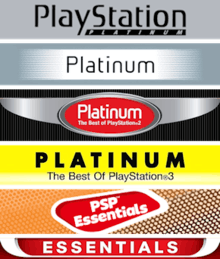Essentials (PlayStation)

Essentials is the Sony PlayStation budget range in the PAL region, which covers Europe, the Middle East, Asia-Pacific and Africa. It was launched in January 1997 as the Platinum range[1] but was later renamed for PlayStation Portable, PlayStation Vita, PlayStation 3 and PlayStation 4. Similar budget ranges from Sony include the Greatest Hits and The Best labels for the North American and Japanese markets, respectively.
Platinum Range titles were recognisable by a platinum/silver coloured band on the game's casing. This band runs along the top of the case's front. In the PlayStation 2 old platinum games it is also common for the silver band to act as a border and to contain the game's original cover, which is shrunk to fill about 75% of the platinum cover. The PlayStation logo is repeated twice on the front case, once on the platinum border, and once on the original game's case. The PlayStation 2 and PlayStation Portable platinum games feature a new layout. They have a black border, and silver outlines around the shrunk original game cover. There is also a red orb located at the bottom of the original game cover with the words Platinum The Best of PlayStation 2 and Platinum The Best of PSP (PlayStation Portable) on it. The platinum band can also be seen on the manual. The PlayStation 3 Platinum range box art replaces the black background of the PlayStation 3 logo on the left with a yellow background, and has the original box art shrunk slightly, with a gray border, and a yellow rectangle on top of it, with 'Platinum' The Best of PlayStation 3 written in black.
PlayStation and PlayStation 2 platinum game discs do not feature any of the original game disc's design, it is replaced with a simple silver design, which, along with the copyright notices around the edges, feature the game's name in the center surrounded by a black outline. PlayStation Portable platinum games use the original games disc design whilst PlayStation 3 platinum games use the original disc design with a platinum design on the disc.
To become a Platinum release it was required that a game have over 400,000 total worldwide sales after generally one year on the market[2] (PAL region sales in particular; games that sell over 400,000 units in another region alone, such as Japan or the U.S., do not necessarily qualify for a Platinum title).
For PlayStation 2 and PlayStation Portable releases, there is no specific target required to achieve Platinum status as indicated by SCEE Press Releases and the discrepancies between the Platinum status of specific titles and their chart performance.
After reaching the required level of sales, Sony often dropped the prices of the original title to Platinum pricing levels (generally about half of the original retail price), as a way to clear inventory for retailers.
The Platinum distinction has since been extended to the however since 2010 they have been renamed Essentials for the PlayStation Portable, PlayStation 3, PlayStation Vita and PlayStation 4. The first PS3 titles were released on August 1, 2008.[3]
For PlayStation 4 games the name was changed to PlayStation Hits. The first games under the new label were released on 18 July 2018 in PS Store and in retail stores for 19.99 € each.[4]
Platinum range
PlayStation titles
PlayStation 2 titles
PlayStation 3 Titles
PlayStation Portable Titles
Essentials range
PlayStation 3 Titles
PlayStation Portable Titles
PlayStation Hits
PlayStation 4
- Uncharted 4: A Thief's End
- LittleBigPlanet 3
- Driveclub
- Ratchet & Clank
- Killzone Shadow Fall
- Bloodborne
- Infamous Second Son
- The Last of Us: Remastered
- Project CARS
- Dragon Ball Xenoverse
- Watch Dogs
- Assassin's Creed IV: Black Flag
- Rayman Legends
- Mortal Kombat X
- Batman: Arkham Knight
- Middle-earth: Shadow of Mordor
- Need For Speed
- Need for Speed Rivals
- EA Sports UFC 2
- Yakuza 0
- Earth Defense Force 4.1: The Shadow Of New Despair
- Dynasty Warriors 8: Xtreme Legends Complete Edition
References
- ↑ "PlayStation History in Europe, Middle East and Asia Pacific - History of Events". Absolute PlayStation. Archived from the original on 10 August 2011. Retrieved 11 November 2013.
- ↑ PlayStation Games & Media News: - PS2 goes Platinum: Part 1
- ↑ "PS3 Platinum range in UK from August". Computer & Video Games. Retrieved 2008-07-21.
- ↑ "PlayStation Hits - PS4-Spiele ab Juli zum Budget-Preis, was lohnt sich?" (in German). Retrieved 2018-06-20.
- ↑ Pro Evolution Soccer 2009 Platinum (PS2)